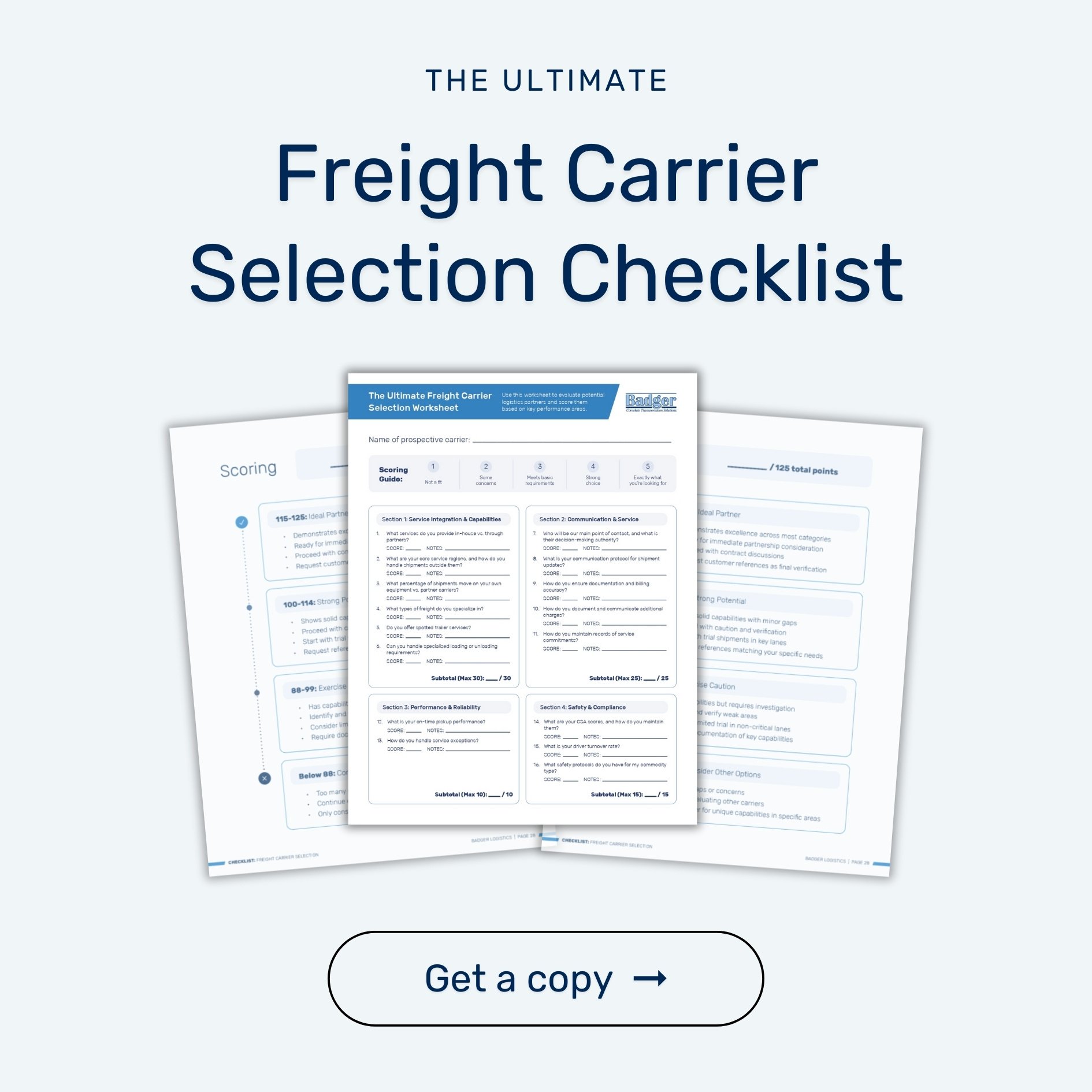Key takeaways
- Strategic geographic advantage - Wisconsin's central location provides access to 40% of the U.S. population within a 24-hour drive time, with proximity to Chicago, Minneapolis-St. Paul, and major waterways creating natural freight corridors.
- Diverse freight profile requires versatile carriers - Wisconsin moves everything from paper products and dairy to manufacturing components and timber, demanding carriers capable of handling various cargo types and equipment needs.
- Distinct seasonal patterns impact shipping - Winter brings weather challenges while agricultural seasons (April-October) create predictable capacity constraints, requiring shippers to plan accordingly.
- Multi-modal options enhance shipping strategies - While trucking dominates, Wisconsin offers rail connections through multiple Class I railroads and maritime shipping via Great Lakes ports, creating opportunities for optimized freight movement.
Badger Logistics provides integrated transportation solutions combining asset-based trucking, brokerage services, and warehousing to overcome Wisconsin's unique logistics challenges. Learn more about our Wisconsin shipping expertise or get a competitive rate quote to join 500+ shippers solving their freight challenges with one call.
A brief introduction
Wisconsin's strategic position in the American Midwest makes it a critical node in the nation's supply chain network. As a transportation hub connecting the Great Lakes region with major markets throughout the United States, Wisconsin's freight lanes serve as vital arteries for the movement of goods across North America.
| Check out the Wisconsin DOT's resources here for detailed Wisconsin freight planning maps. |
Source: Wisconsin DOT — Freight Maps (OSOW-TR, High Clearance, Wind Tower Corridor) — Statewide Map
Wisconsin's strategic geographic advantage for shipping freight
Wisconsin sits at a unique crossroads in America's heartland. Bordered by Lake Michigan to the east, Lake Superior to the north, and the Mississippi River to the west, the state benefits from access to multiple transportation modes. This geographical position creates natural freight corridors that have been enhanced by modern infrastructure investments.
The state's proximity to major metropolitan areas creates distinct advantages for shippers. Wisconsin is ideally situated within a day's drive of several critical markets:
- Just 90 minutes from Chicago, the nation's third-largest metropolitan area
- Approximately 5 hours from Minneapolis-St. Paul
- Within a day's drive of Detroit, Indianapolis, St. Louis, and Milwaukee
- Reasonable access to both Canadian markets and southern shipping lanes
This central position means that goods shipped from Wisconsin can reach approximately 40% of the U.S. population within a 24-hour drive time, making it an efficient distribution point for manufacturers and distributors alike.
Major freight corridors in Wisconsin
Wisconsin's freight infrastructure is organized around several key corridors that facilitate the movement of goods both within the state and to external markets:
The I-94 CorridorThe most significant east-west route through Wisconsin connects Madison and Milwaukee with Minneapolis-St. Paul to the west and Chicago to the southeast. This corridor handles the highest volume of truck traffic in the state and serves as the primary conduit for goods moving between the Upper Midwest and the East Coast. |
The I-90 CorridorRunning parallel to I-94 in the western portion of the state, I-90 provides another critical east-west route connecting La Crosse and the Mississippi River region with Madison before continuing toward Chicago. |
The I-43 CorridorThis north-south artery connects Milwaukee with Green Bay and the Fox Valley, supporting the paper and packaging industry that dominates manufacturing in northeastern Wisconsin. |
The Highway 151 CorridorA crucial diagonal route connecting Madison with Dubuque, Iowa to the southwest and Fond du Lac and the Fox Valley to the northeast. This corridor serves as an alternative route for freight moving between southwestern Wisconsin and the Fox Valley manufacturing centers. |
The US-41 CorridorAnother vital north-south route running from the Illinois border through Milwaukee and the Fox Valley to the Upper Peninsula of Michigan, serving as a backbone for Wisconsin's paper and manufacturing industries. |
Wisconsin's freight profile: what moves on these lanes?
Understanding Wisconsin's freight lanes requires familiarity with the state's economic base. The primary commodities moving through Wisconsin's transportation network include:
- Paper and packaging products: Wisconsin remains one of the nation's leading paper producers, with mills concentrated in the Fox Valley and northern regions of the state.
- Food and dairy products: As "America's Dairyland," Wisconsin ships massive quantities of cheese, milk, and other dairy products throughout the country, requiring both standard dry van and refrigerated transportation.
- Manufacturing components: Wisconsin's strong manufacturing base, particularly in machinery, electrical equipment, and transportation equipment, generates significant freight volumes.
- Agricultural products: Beyond dairy, Wisconsin produces substantial volumes of corn, soybeans, cranberries, and other agricultural commodities that move through the state's freight network.
- Forest products: The northern regions of Wisconsin maintain a robust timber industry, producing pulpwood, lumber, and furniture components.
The diversity of Wisconsin's freight means that carriers operating in the state must be versatile, capable of handling everything from temperature-sensitive food products to oversized manufacturing equipment.
Seasonal considerations for Wisconsin freight
Wisconsin's freight patterns display distinct seasonal variations that shippers must account for when planning transportation. Here's a quick rundown of what we suggest shippers keep in mind.
Winter challenges (November-March)The winter months bring significant challenges to Wisconsin's freight lanes, with several factors impacting transportation:
|
Agricultural season (April-October)The growing and harvest seasons transform Wisconsin's freight patterns:
|
Manufacturing cyclesWisconsin's manufacturing economy often follows cyclical patterns that impact freight demand:
|
Intermodal options within Wisconsin's freight network
While truck transportation dominates Wisconsin's freight movement, the state offers several intermodal options that provide alternatives for certain shipments:
Rail infrastructureWisconsin is served by several Class I railroads, including:
These rail lines connect Wisconsin's manufacturing centers with intermodal facilities in Chicago, Minneapolis, and elsewhere, providing options for long-haul shipments. |
Maritime shippingWisconsin's position on the Great Lakes provides access to marine transportation, with major ports in:
These ports handle bulk commodities and offer connections to the global shipping network through the Great Lakes-St. Lawrence Seaway system. |
Optimizing your Wisconsin shipping strategy
For shippers operating in or through Wisconsin, several strategies can help optimize freight movements and control costs:
- Understand seasonal patterns: Plan for weather-related disruptions in winter and capacity constraints during harvest season.
- Consider regional carriers: Wisconsin-based carriers often have specialized knowledge of local lanes and relationships with facilities that can provide advantages over national carriers.
- Explore backhaul opportunities: Wisconsin's balanced manufacturing economy means that trucks entering the state with raw materials often seek outbound freight, creating potential rate advantages.
- Leverage Wisconsin's central location: For distribution networks, Wisconsin's proximity to major Midwest markets makes it an excellent consolidation point.
- Maintain capacity relationships: The seasonal nature of Wisconsin freight means that building strong carrier relationships is essential for securing capacity during tight markets.
Ready to optimize your Wisconsin shipping? Let's talk
At Badger Logistics, we've been navigating Wisconsin's freight lanes since 1993. Our strategic location in Fall River puts us at the heart of the state's transportation network, with easy access to Highway 151 and just minutes from major interstate connections.
We don't just understand Wisconsin's freight landscape – we live it every day. Our team combines decades of experience with the flexibility to respond to the unique seasonal challenges and opportunities that Wisconsin shipping presents.
Whether you need asset-based trucking for reliable capacity on regional lanes, brokerage services for nationwide reach, or food-grade warehousing to support your distribution strategy, we provide the integrated logistics solutions that Wisconsin shippers depend on.
Stop struggling with carriers who don't understand Wisconsin's unique shipping environment. Experience the Badger difference – where 97% on-time delivery performance and rapid response times come standard.
Contact us today for a personalized consultation and competitive rate quote. We'll analyze your specific shipping patterns and design a Wisconsin-optimized logistics strategy that delivers real results for your business.






